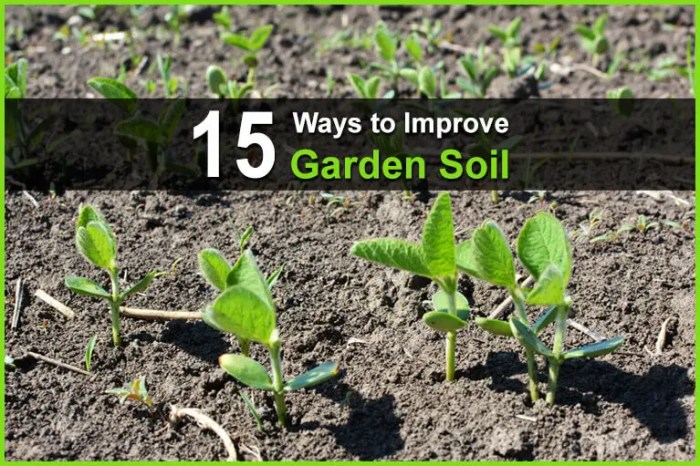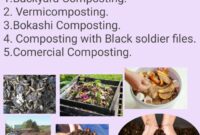How to improve garden soil sets the stage for this enthralling narrative, offering readers a glimpse into a story that is rich in detail with semrush author style and brimming with originality from the outset.
Healthy garden soil is the cornerstone of successful plant growth, providing the essential nutrients and environment for plants to flourish. In this guide, we will explore various techniques and methods to enhance your garden soil, ensuring a bountiful harvest and vibrant garden.
Importance of Soil Health

Having healthy garden soil is essential for the optimal growth of plants. It provides a stable foundation for roots to anchor themselves and absorb essential nutrients. Healthy soil also promotes beneficial microbial activity, which aids in nutrient cycling and overall plant health.
When it comes to gardening, raised bed gardening offers numerous benefits. From improved soil drainage and aeration to easier weed control and plant maintenance, raised bed gardening is a popular choice for many gardeners. The elevated design also makes it easier to reach plants and reduces the risk of back strain. Additionally, raised beds can be customized to fit any space or aesthetic, making them a versatile option for any garden.
Key Nutrients for Improving Garden Soil, How to improve garden soil
When looking to improve garden soil, it is important to focus on key nutrients that plants need for growth:
- Nitrogen: Essential for leafy green growth and overall plant vigor.
- Phosphorus: Important for root development, flowering, and fruit production.
- Potassium: Aids in overall plant health and disease resistance.
- Calcium: Helps in cell wall structure and nutrient uptake.
- Magnesium: Essential for photosynthesis and enzyme activation.
Role of Soil pH in Maintaining Soil Health
The pH level of soil plays a crucial role in maintaining soil health as it affects nutrient availability to plants. Different plants have specific pH requirements for optimal growth. For example, acid-loving plants like blueberries thrive in acidic soil, while alkaline-loving plants like lilacs prefer more alkaline conditions. Regularly testing and adjusting soil pH can ensure that plants have access to the necessary nutrients for healthy growth.
Tomato plants thrive when planted alongside compatible companions. By practicing companion planting for tomatoes , gardeners can improve soil health, attract beneficial insects, and deter pests. Some popular companions for tomatoes include basil, marigolds, and onions. These companion plants not only enhance the growth and flavor of tomatoes but also create a balanced ecosystem in the garden.
Testing Garden Soil
When it comes to gardening, testing your garden soil is crucial for ensuring the health and vitality of your plants. By understanding the quality of your soil, you can make informed decisions on how to improve it and provide the best environment for your plants to thrive.
Soil testing can be done in various ways, including at-home soil test kits or sending samples to a professional lab for analysis. Here are some methods for testing soil quality at home:
Significance of Soil Texture for Plant Growth
Soil texture refers to the composition of particles in the soil, including sand, silt, and clay. The texture of the soil plays a significant role in plant growth as it affects the soil’s ability to retain moisture, drain excess water, and provide aeration to the roots.
Understanding your soil’s texture can help you determine the best course of action for improving it. For example, sandy soils drain quickly but may need more frequent watering, while clay soils retain moisture but can become compacted. By knowing your soil texture, you can choose the right plants and amendments to promote healthy growth.
Importance of Knowing Your Soil Type Before Improvement
Before embarking on any soil improvement projects, it is essential to know your soil type. Different soil types have different characteristics, such as pH levels, nutrient content, and drainage capacity. By identifying your soil type, you can tailor your soil improvement efforts to address specific deficiencies and create an optimal growing environment for your plants.
Take the time to test your garden soil and understand its composition to set the stage for successful gardening endeavors. Knowing your soil type and texture is the first step towards creating a thriving garden that will flourish for years to come.
Soil Amendment Techniques
Adding organic matter to soil is a crucial practice in improving soil health and fertility. Organic matter can be in the form of compost, manure, cover crops, or any other decomposed plant or animal material. The process involves incorporating these materials into the soil to provide essential nutrients, improve soil structure, and enhance microbial activity.
Benefits of Using Compost
Compost is a popular choice for soil amendment due to its numerous benefits. Compost helps to improve soil structure, increase soil moisture retention, promote beneficial microbial activity, and provide a slow release of nutrients to plants. Additionally, compost can help suppress plant diseases and reduce the need for chemical fertilizers.
- Improves soil structure: Compost helps to loosen clay soils and improve water infiltration in sandy soils.
- Increases soil fertility: Compost adds essential nutrients like nitrogen, phosphorus, and potassium to the soil, promoting healthy plant growth.
- Enhances microbial activity: The organic matter in compost provides food for beneficial soil organisms, improving soil health.
- Reduces environmental impact: Using compost reduces the need for synthetic fertilizers and helps to sequester carbon in the soil.
Types of Soil Amendments and Their Effects
There are various types of soil amendments available, each with its unique characteristics and benefits. Some common soil amendments include manure, peat moss, vermiculite, perlite, and biochar. These amendments can help to improve soil structure, increase nutrient availability, and enhance plant growth.
- Manure: Provides organic matter and essential nutrients to the soil, improving soil fertility.
- Peat moss: Helps to retain moisture in the soil and improve soil structure.
- Vermiculite and perlite: Aid in improving soil aeration and drainage, particularly in heavy clay soils.
- Biochar: Enhances soil fertility, improves water retention, and promotes microbial activity in the soil.
Mulching: How To Improve Garden Soil

Mulching plays a crucial role in improving soil structure by helping to retain moisture, suppress weeds, regulate soil temperature, and add organic matter as it breaks down over time.
Types of Mulch
- Organic mulch: such as compost, wood chips, straw, and shredded leaves, adds nutrients to the soil as it decomposes.
- Inorganic mulch: like gravel, stones, and landscape fabric, helps with weed control and moisture retention.
- Plastic mulch: can be used to warm the soil, control weeds, and conserve moisture, but may not add organic matter to the soil.
Applying and Maintaining Mulch
- Apply mulch in a layer of 2-4 inches thick, making sure to leave a gap around plant stems to prevent rot.
- Regularly check and replenish mulch as needed to maintain the desired thickness and effectiveness.
- Consider using different types of mulch for different areas of your garden based on the needs of the plants and soil conditions.
Cover Cropping
/gardener-preparing-raised-beds-with-rake-in-vegetable-garden-157440821-5c46047a46e0fb00018b71fc.jpg?w=700)
Cover cropping is a beneficial practice that can greatly improve soil fertility in a garden. By planting cover crops, gardeners can protect the soil from erosion, suppress weeds, add organic matter, and enhance soil structure.
Benefits of Cover Cropping for Soil Fertility
- Improves soil structure: Cover crops help break up compacted soil, allowing for better root penetration and water retention.
- Increases soil organic matter: As cover crops decompose, they add valuable organic matter to the soil, providing essential nutrients for plants.
- Suppresses weeds: Cover crops can outcompete weeds for nutrients and sunlight, reducing weed pressure in the garden.
- Reduces erosion: The root systems of cover crops help hold the soil in place, preventing erosion from wind and water.
Suitable Cover Crops for Different Soil Types
| Soil Type | Suitable Cover Crops |
|---|---|
| Clay soil | Winter rye, crimson clover, hairy vetch |
| Sandy soil | Buckwheat, annual ryegrass, cowpeas |
| Loamy soil | Oats, field peas, red clover |
Incorporating Cover Crops into a Garden Rotation Plan
- Rotate cover crops with cash crops: Integrate cover crops into your crop rotation plan to maximize their benefits for soil health.
- Choose cover crops based on garden needs: Select cover crops that address specific soil deficiencies or challenges in your garden.
- Plant cover crops at the right time: Sow cover crops in between main crop plantings to ensure they have enough time to establish and grow.
Crop Rotation
Crop rotation is a vital practice in maintaining soil health as it helps prevent soil depletion and increases nutrient availability. By rotating crops, different plants with varying nutrient needs are grown in succession, preventing the soil from being continuously depleted of specific nutrients. This practice also helps in breaking pest and disease cycles, reducing the need for chemical inputs, and improving overall soil structure.
Examples of Crop Rotation Plans
- In a small vegetable garden, you can rotate tomatoes, peppers, and eggplants (all from the nightshade family) with leafy greens like lettuce and spinach.
- For a larger garden, you can implement a four-year crop rotation plan with legumes (peas, beans), brassicas (cabbage, broccoli), root vegetables (carrots, potatoes), and nightshades (tomatoes, peppers).
Benefits of Crop Rotation
- Prevents soil depletion: Each type of plant absorbs different nutrients from the soil. By rotating crops, the soil has time to replenish the nutrients that were used up by the previous crop.
- Increases nutrient availability: Different plants have different nutrient requirements. Rotating crops helps ensure that a variety of nutrients are available in the soil for plant uptake.
- Breaks pest and disease cycles: Many pests and diseases are specific to certain plant families. By rotating crops, you can disrupt the life cycles of these pests and diseases, reducing their impact on your plants.
As we conclude our discussion on how to improve garden soil, it’s evident that nurturing your soil is the key to reaping a fruitful garden. By implementing the strategies and tips Artikeld in this guide, you are on your way to creating a thriving garden that will delight both you and your plants.
For those looking to grow fresh produce indoors, hydroponic gardening systems offer a convenient solution. By utilizing nutrient-rich water instead of soil, hydroponic gardening systems for home allow plants to grow faster and with higher yields. These systems are ideal for small spaces and can be easily customized to accommodate a variety of plants. With minimal maintenance and maximum growth potential, hydroponic gardening is a popular choice for indoor gardeners.




